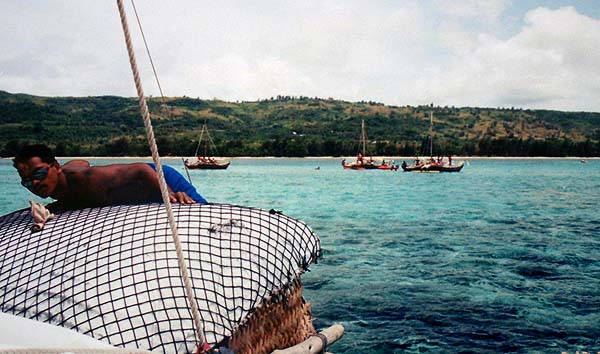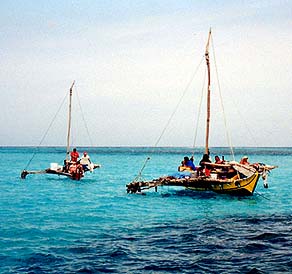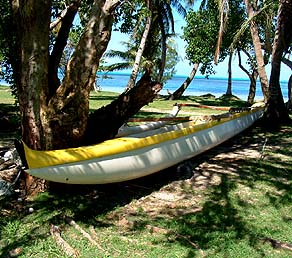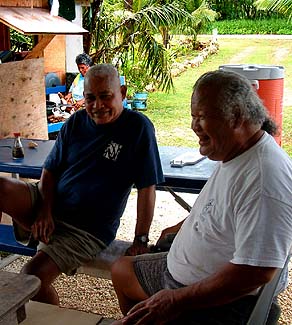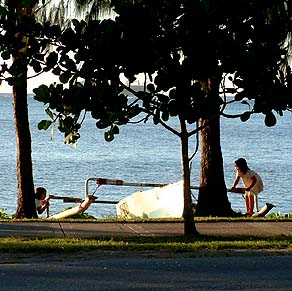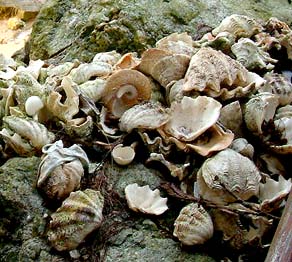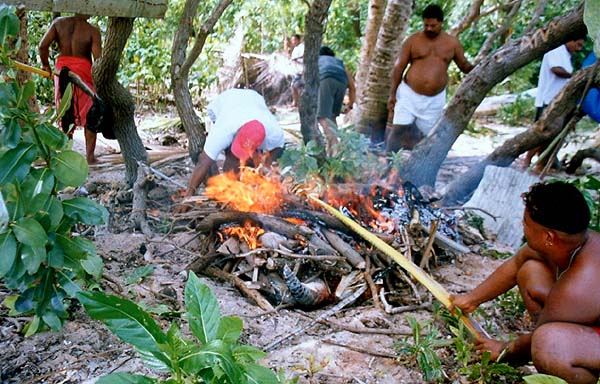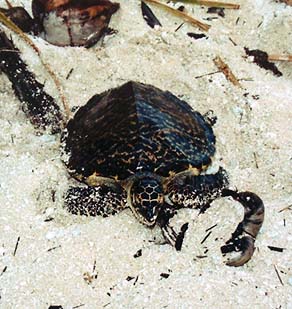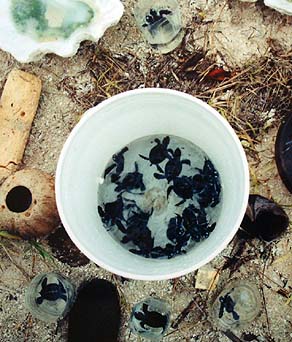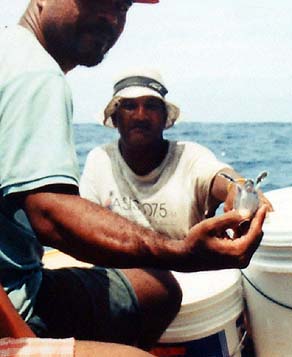 |
 |
 |
|||||
|
|
|
|
|
|
|
|
|
|
|
|||||||
|
|
|
|
|
|
“We began reconnecting to the Central Carolines back in the ‘60s,” Ben says. “People from Satawal, and probably Lamotrek or Woleai, would get together in Satawal and plan a trip to come up here and visit relatives and maybe exchange certain things from the Central Carolines. And this has continued on, all the way to the year 2000. "And in the year 2000, for the first time, Tanapag Beach was a port of call for six of these ocean-voyaging canoes. It was a very elaborate celebration. A lot of people came down to watch, and to greet their relatives. Mau Piailug was the organizer from that part. We have the Carolinian office as a liaison between all of these people. And that’s why I think it is very important for our government to continue to have the Carolinian office function.”
|
||
|
|
||
“The canoes have been coming on an annual basis, though there are times when Mau is busy elsewhere, and there are years when no canoes show up. I participated again last year, in April; we came from Satawal and our arrival coincided with the Arts Council activities. We flew down to Yap and chartered a fishing vessel to go to Satawal. It’s about 800 miles from Yap. Then we sailed the canoes from Satawal to Saipan. “I’d love to get a Carolinian canoe for the village. That’s my goal. I think eventually when I get to know more about the structure of the canoe, I’d be able to write a grant proposal for our government and probably for the Federal Government, and see what money we can get from that, and perhaps go and purchase one ourselves, or have somebody make one for us here in the village so that we know about it from its very beginning."
|
|
|
“We would have difficulties trying to build a canoe; we must learn the canoe and appreciate it before we can build one. So we’re not really anticipating to build one. We want to write a grant proposal to bring somebody here, and identify people like Mau and his brother Urupa to come and build one here. "That way we can have a first-hand look, and learn the parts and the names in Carolinian of the sections of the canoe. And to get a breadfruit tree or monkeypod large enought for the body of it, we might have to go to Rota. Saipan just doesn’t have the kind of breadfruit tree for a large ocean-going canoe.”
|
|
|
|
“Mau makes a pilgrimage from Satawal almost annually. And because he does this every year, we all got excited and interested in getting our young children, and maybe some of the older guys, to go out and venture into this cultural exchange. "We’ve been very happy with this, and we praise Mau for doing it, because we know that the ancient art of navigation is sort of a secret deal for a clan or a family. Mau has broken that and decided to teach it because he has seen that it is disappearing, and he was afraid it would disappear from the face of the earth, and nobody would know about it any more. And I think he’s the last of the last. But, thanks to him, we now have several of us here in Tanapag learning these arts."
|
|
|
“I think Mau’s idea is to relive, to revisit the culture that is very quickly declining. We’re not practicing it any more. Nobody’s building canoes here any more. And Mau said, ‘You know, if I don’t teach you guys my knowledge, you will lose it.’ "We will all lose it, and we’ve lost a lot because so many of these traditions are practiced within a clan or family. For example, there are certain clans or families that build canoes, and most of them are gone. So we encourage the young people to get involved and to be interested. I guess that’s our mission.”
|
|
|
|
"If you look back at our tradition," Dave remarks, "for a long time we harvested whatever resources we had on the land and in the ocean as part of our life. That is our privilege, and we have to be prepared to harvest it.
|
||
|
|
||
"But changes occur when a new administration comes into our place and regulates the resources that we have here. Like, for example, the fruit bats, the deer, the fish. We need to observe and protect those regulations because right now it’s very hard to find those species that we had before. It’s very hard to find them now. A long time ago we had a lot of fruit bats; now it’s very seldom that you look up in the sky during night time and see fruit bats flying around. "Banning the net fishing is not entirely bad, but we have to look back to that part of the system that is part of our culture. We don’t need to totally ban net fishing, because that is what we look forward to doing, but we need to utilize it wisely. We need to take the net out to the water and catch only enough fish for our consumption."
|
|
|
"Net fishing should remain especially for fiesta—that’s part of the custom. We gather the people to go outside and look for the fish, the school of fish, and we trap them in the net and bring them in and then we utilize them as part of what we consume during fiesta. "Some people suffer a lot right now because they’re not employed and they have to depend on the ocean resources and the land resources. And whenever they go out and harvest the ocean or the water resources, they might be arrested because of the regulations of the wildlife like that. "If the government would make certain resources available in a certain season, that might be some way to work together between the regulations and the needs of the people."
|
|
|
|
|
“Turtle was a staple food and diet for the village of Tanapag.” Ben explains the significance of the turtle and proposed means for balancing preservation with cultural use. “Turtle is considered a delicacy here. We used to go out and hunt for turtles, bring one home and divide the meat amongst the family. We usually cooked it on its back, since in those days we didn’t have big pots. “Turtles have not only cultural use but also medicinal use. The fats in the green turtle, mixed with fragrant flowers like ilangilang, are preserved, and the old timers use it for massage or for treating painful areas. "I remember another distinct tradition—I tried it but I don’t have the stomach to do it every time. The older folks will give you the blood of the turtle to drink, and many young boys drink turtle blood. I tried it but it’s too rich for me, or maybe I was scared, I don’t know. The blood, it’s medicinal. Some young boys who look emaciated, they’d give them turtle blood and, boy, they would expand. It must be good."
|
||
|
|
||
“Now the federal government has listed green turtle as a threatened species and so it’s not allowable to use them for culture, or use them for medicine. We continue to ask National Marine Fisheries, U.S. Fish and Wildlife, to allow us cultural use. Just as they have allowed Inuits and they have allowed American Indians to harvest salmon, whales, seals, those animals that are considered threatened or endangered under certain treaties and covenant agreements. Those cultural uses are allowable I guess by certain applications of the Endangered Species Act. “Today turtles are abundant, and we have requested to harvest ten turtles a year with the condition that we will raise more than 100 young turtles a year. U.S. Fish and Wildlife wanted more data, more information on the turtles before making a decision as to whether we’re going to get our request."
|
|
|
“But the irony of the Endangered Species Act is that there is no enhancement. Turtles are protected only, but nobody is here raising them to the age where they won’t be preyed on. Turtles normally hatch about 100 young, but only a few of them survive. So if we could preserve those areas where turtles come back to nest, and help the young hatchlings reach the ocean, that would enhance the population, and would bring more turtles back to the island. "In the olden days we used to wait for the hatchlings to come up, and we’d and pick them up and take them by boat out to the ocean and release them individually. We think that approach prevents a lot of predation, because predation starts on the beach from birds and land crabs. "There’s a season around April when turtles start nesting, and around May the hatchlings start to come up from the sand. And the sharks start calving also around that time, so as soon as the turtle gets in the water, the juvenile sharks would start feeding on them. And birds would start feeding on them, octopus would feed on them, and very few would survive."
|
"Conservation and enhancement starts with young people. I feel that if young people harvested turtles, they would understand the biology and all the things about turtles. Because we would be harvesting only ten, we would ask young people to participate in the hatchling release, and I think that would give them more insight and information and knowledge about turtles so that they don’t go out and hunt them indiscriminately. "I think that kind of knowledge and understanding would bring more turtles to the island: just the mere fact that we understand the nature of turtles. Respect is probably the best word: you respect the animal in the water and make sure that they perpetually are on the island for cultural use and for medicinal purposes. So I believe that actually having a cultural-use harvest would in the long term be better, and engender more respect by people for the turtle."
|
|
|
|
|
This strong connection to the sea that remains an important part of culture in Tanapag also manifests in the urge to rebuild and preserve the tradition of having an utt, which might be described as one of the sacred sites of Tanapag.
|
||
|
|
||
|
|
|
|
|
|

|
| Tanapag Home | Map Library | Site Map | Pacific Worlds Home |
|
|
|
|

|
|
|
|||
| Copyright 2003 Pacific Worlds & Associates • Usage Policy • Webmaster |
|||
